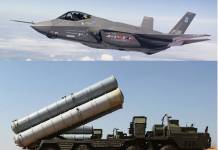A mockup of the Chinese Shenyang FC-31 stealth fighter jet was spotted at the Wuhan aircraft carrier testing facility.
While Shenyang FC-31 is supposedly a land-based aircraft, this mockup could signal towards a possible naval-based adaptation of the fighter jet, according to reports by the Global Times.
The model resembled the design of FC-31 such as the wings, missiles, and the tail fin with a PLA insignia on it.
The 2020 Pentagon report on Chinese military developments had noted the development of the smaller FC-31/J-31 for export, calling it “a future naval fighter for the PLAN’s next class of aircraft carriers”.
What is FC-31?
The FC-31 is China’s second stealth fighter jet developed by Shenyang as a private venture. A medium-sized, single-seat, twin-engine, and multi-role fighter jet, it has not made the cut for the PLA service yet.
The aircraft has been in the news since 2014 when an earlier version made its first appearance at an Airshow in China.
The state-run Global Times reported on possible new prototypes being developed with modifications and upgraded designs. In 2019, Shenyang announced developing a “new fighter”, however, no further details have been shared yet.
Recently, the jet featured in the official poster released by Aviation Industry Corporation of China (AVIC) along with other military aircraft such as the GJ-11 stealth armed reconnaissance drone, Y-20 large transport plane, Z-20 utility helicopter, and J-20 stealth fighter jet.

Experts within and outside China have observed how this could be PLA’s next-generation carrier-based fighter jet, replacing the incumbent Chengdu J-15 that entered service in 2019.
Type 003 Aircraft Carrier
The sighting of FC-31 comes amid the renewed push of the PLA Navy (PLAN) to launch its third and the largest aircraft carrier this year, speculated to be ‘Type 003 Class’ in the backdrop of rising geopolitical and maritime disputes.

The indigenously-developed aircraft carrier has been under construction at the Jiangnan Shipyard outside Shanghai since early 2018. It will be the first to introduce electromagnet catapults, replacing the ‘ski-jump’ system currently used in other carriers.
This is keeping in line with China’s push towards modernizing its military and naval operations to counter US influence in the South China Sea and beyond.
If military experts and Sinologists are to be believed, the oceans will be the next playground for a geopolitical deadlock between a rising China and the incumbent hegemon US. To strengthen its naval hard power, China has a plan underway to increase the number of nuclear attack submarines, aircraft carriers, warships, and the size of the Marine Corps.
If China succeeds in developing an indigenous carrier-based fighter jet, it will join the elite club of three countries that have done it so far.




